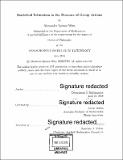Statistical estimation in the presence of group actions
Author(s)
Wein, Alexander Spence
DownloadFull printable version (13.81Mb)
Other Contributors
Massachusetts Institute of Technology. Department of Mathematics.
Advisor
Ankur Moitra.
Terms of use
Metadata
Show full item recordAbstract
Imagine we want to recover an unknown vector given many noisy copies of it, except each copy is cyclically shifted by an unknown offset (this is "multi-reference alignment"). Or imagine we want to reconstruct an unknown 3D structure (e.g. a molecule) given many noisy pictures of it taken from different unknown angles (this is "cryo-EM"). These problems (and many others) involve the action of unknown group elements drawn randomly from a compact group such as Z/p or SO(3). In this thesis we study two statistical models for estimation in the presence of group actions. The first is the synchronization model in which we attempt to learn an unknown collection of group elements based on noisy pairwise comparisons. The second is the orbit recovery model in which we observe noisy copies of a hidden signal, each of which is acted upon by a random group element. For both of these models, we explore the fundamental statistical limits as well as the fundamental computational limits (i.e. how well can a polynomial-time algorithm perform?). We use methods from a wide variety of areas, including statistical physics, approximate message passing, representation theory, contiguity and the associated second moment method, invariant theory, algebraic geometry, and the sum-of-squares hierarchy..
Description
Thesis: Ph. D., Massachusetts Institute of Technology, Department of Mathematics, 2018. Cataloged from PDF version of thesis. Includes bibliographical references (pages 199-210).
Date issued
2018Department
Massachusetts Institute of Technology. Department of MathematicsPublisher
Massachusetts Institute of Technology
Keywords
Mathematics.